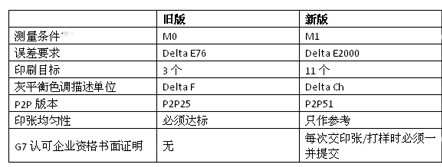[China Packaging Network] US IDEAlliance released new qualification requirements for G7 companies in early May of this year. From July 13 to July 15, IDEAlliance China held G7 experts in Hong Kong and Shenzhen respectively. The meeting of the G7 company mainly focused on the new G7 qualification requirements. 
The old and new versions of G7 are easier to compare
As ISO12647-2 has released a new version of 2013 in the previous period, the main content is to change the measurement conditions from M0 to M1 and formulate 8 kinds of printing conditions, and the new G7 qualification requirements are also modified in this direction. In addition to this, it emphasizes that SCCA can be used to adjust the target database based on paper white, because it can be closer to actual production needs.
At the same time, the new eligibility requirements put more emphasis on the need for enterprises to actually grasp the G7 theory and have the ability to operate. Therefore, a special “G7 Approved Corporate Evidence Written Proof†was added to this purpose. The purpose is to strengthen the monitoring of the quality of G7 companies. It must be signed by a G7 expert and a G7 company representative and submitted to IDEAlliance China when submitting the press sheet. The specific new version of the old version of the qualifying requirements is shown in the table below:

*Note 1: M0 does not define the amount of UV energy contained. The paper fluorescer will affect the matching of the measurement data and the vision. This mode is the measurement method for most measuring devices; M1 defines the amount of UV energy contained and can be compensated. The influence of the paper fluorescent brightener on the measurement data makes the data more suitable for the D50 conditions, which in turn makes the measurement data more consistent with the vision.
Regarding the uniformity of printing, there will be one P2P on the left and right sides of the submitted certification sheet. In the past, the color difference of the two CMYK color blocks of the two P2Ps must meet the ΔE76≦3, and it is within the IT8.7/4. The color difference of CMYK color blocks must meet ΔE76≦6, and this average value has been changed from “must†to “only for data reference†in the new qualification requirements; and another feature is the two P2P Both the NPDC and the gray balance must pass, but in the new requirement, only one P2P can be passed left or right.
Increase the authentication level to optimize the certificate application process
At present, G7's certification levels are Grayscale, Targeted, and Colorspace. Considering that paper may not meet the database requirements, printing companies can apply for Targeted Relative or Colorspace Relative, and this modification also adds G7 Native CMY. This level, this level is mainly for digital printing without using color management software for conversion, but also to meet the G7 requirements.
With respect to the certification certificate, under the old system, if the company itself already has a certification level of printing (or proofing), if the company wishes to take one more level of certification, it will need to make another application. This will increase the number of certifications. The time and cost of the certification; but under the new system, at the same time as the new certification or renewal of the license, as long as an additional small amount of fees and the required documents and printed sheets are available, companies can apply for a single level of certification at the same time.
Continued popularity of G7 certification also greatly improved operability
Currently in the printing industry, in addition to G7, there are Fogra PSO, Ugra PSO, or PSA, but the market share of G7 certification is still relatively large. In addition to the cost of certification, it is mainly a simple and clear operation guideline. It makes it easier for operators to understand how to meet the requirements of certain standard databases. G7 is a set of calibration methods that can be applied to all CMYK output devices. Therefore, it is widely used. In addition, G7 advocates the concept of printing by data (print by Number) also emphasizes the consistency between the final result and the appearance of the target color. It means that the data is consistent with the result. It is not blindly pursuing the data. Finally, the data can reach the target and the customer can receive the goods satisfactorily.
It is not difficult to understand G7, but it is an important issue to be able to use this method flexibly in production. First of all, G7 is a method that aims to get an appearance that is close to the target color through gray balance. However, due to the problem of phosphors in printed paper, if it is still forced to be in line with the ISO standards, it will be caused by fluorescent agents on the paper. Color is difficult, so the G7 now also joins the SCCA element. Now, if you want to use the G7 more smoothly, you can use the Devicelink Profile at the same time. With effective color conversion, you can achieve the color standard of GRACoL or SWOP more quickly ( Both standards are achieved through the G7 to ISO requirements), which greatly improves operability.
